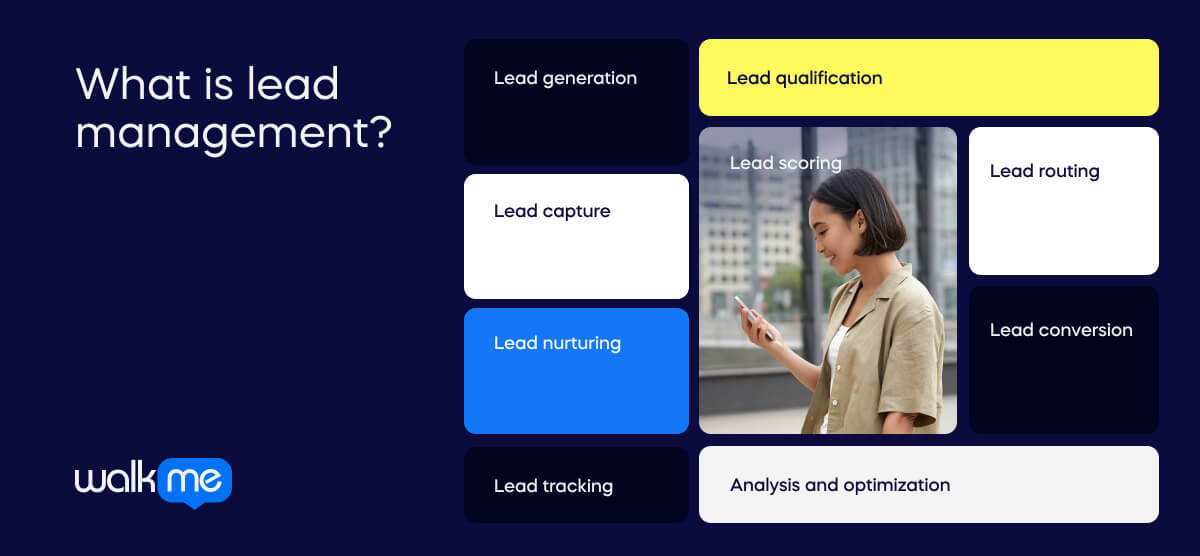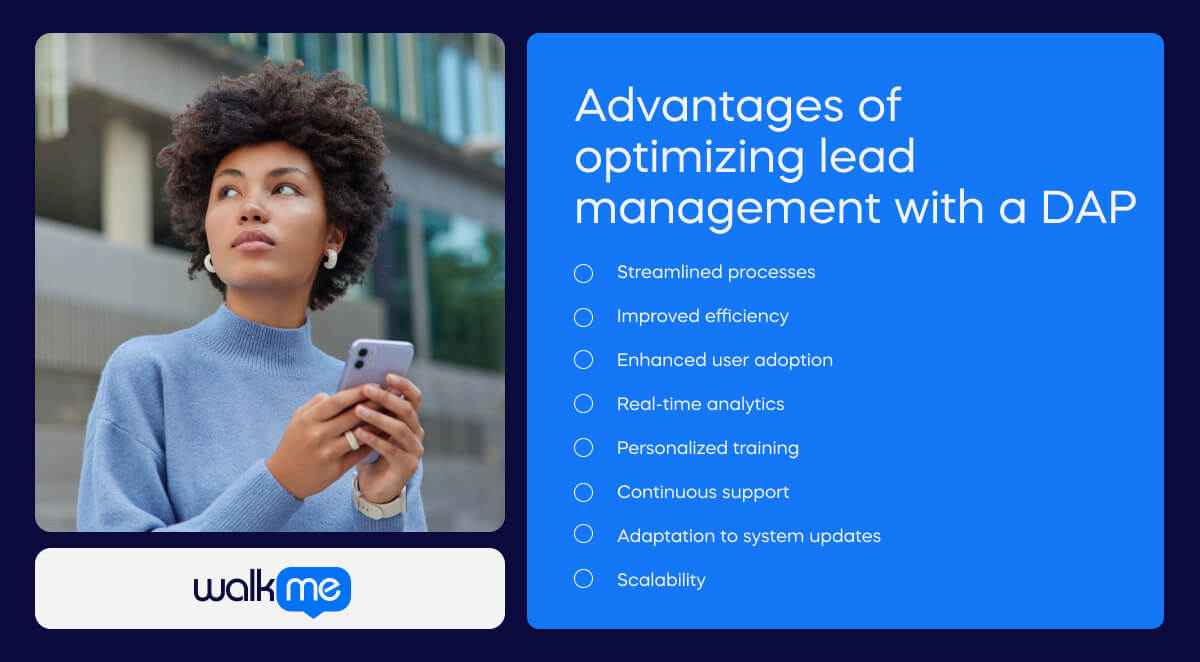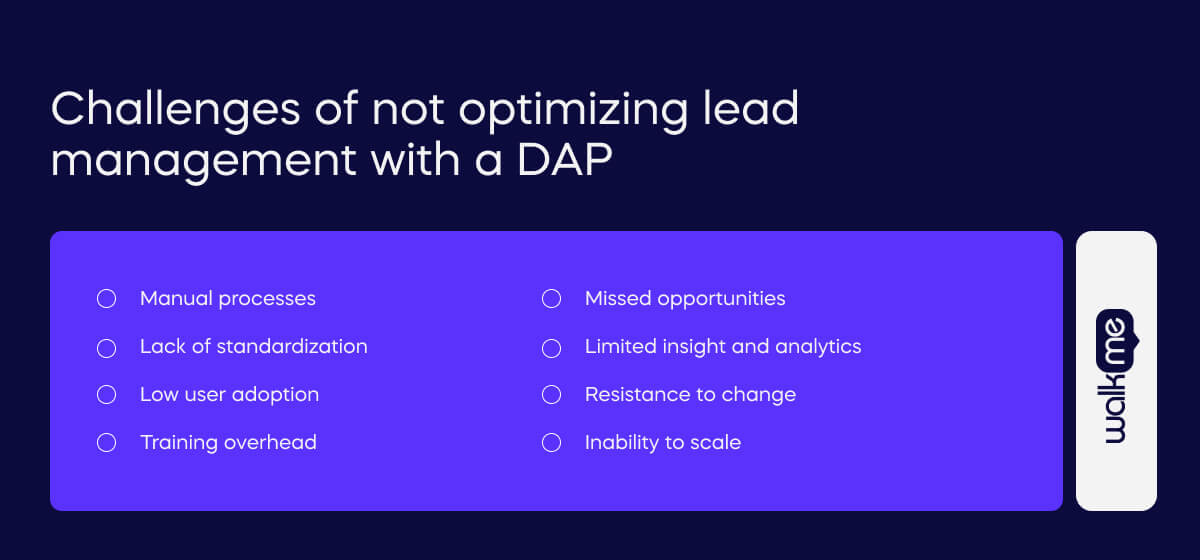What is lead management?
Lead management refers to the process of acquiring, tracking, and nurturing potential customers or “leads” throughout their journey from initial contact to becoming a customer.

Table of contents
- What is lead management?
- How can DAPs enhance and streamline lead management strategy?
- Use cases for lead management
- Lead management vs customer relationship management (CRM)
- Advantages of optimizing lead management with a DAP
- Challenges of not optimizing lead management with a DAP
- Integrating DAPs with lead management strategy
Lead management involves strategies and systems for identifying, qualifying, and prioritizing leads and managing communication and interactions with them to move them through the sales funnel effectively.

Effective lead management is crucial for sales and marketing teams to optimize their efforts and drive revenue growth. Lead management typically includes activities such as:
Lead generation
Attracting potential customers through marketing efforts.
Lead capture
Collecting lead information through various channels.
Lead qualification
Assessing leads based on criteria like budget and need.
Lead scoring
Assigning scores to prioritize and gauge lead interest.
Lead nurturing
Building relationships with leads through personalized communication.
Lead tracking
Monitoring lead interactions and behavior.
Lead routing
Assigning leads to appropriate sales representatives.
Lead conversion
Closing deals through effective sales follow-up.
Analysis and optimization
Continuously refining strategies based on data insights.
How can DAPs enhance and streamline lead management strategy?
Using a CRM for lead management offers several benefits:
- Centralizes lead data
- Facilitates tracking and monitoring throughout the sales pipeline
- Enables personalized lead nurturing and segmentation
- Streamlines process through automation
- Integrates with marketing and sales tools for seamless collaboration
- Provides robust analytics for performance analysis and decision-making
What’s more, the CRM market is growing year on year:
- The global market for CRM software is projected to reach $49.6 billion by 2025
- Between 2022 and 2030, the market value is expected to grow 13% per year
- 57% of businesses see CRM platforms as the most valuable software
Streamlining lead management strategy is made even better when digital adoption platforms (DAPs) enter the picture. Here’s how:
User guidance within CRM
DAPs can provide in-app guidance and tutorials directly within the CRM interface. WalkMe can be integrated with popular CRM systems such as Salesforce, HubSpot, Zoho, and others to provide interactive guidance and support to CRM users. It can provide:
- On-screen walkthroughs that show sales teams how to use the CRM system to create, update, and track leads
- Contextual tips and hints that help users avoid common errors and follow best practices for lead management
Automated workflows
Another benefit DAP integration can provide is automating repetitive tasks within the CRM system. WalkMe can automate tedious and time-consuming tasks within the CRM system using Smart Walk-Thrus and ShoutOuts. For example, WalkMe can:
- Automatically fill in lead information from web forms
- Assign leads to the appropriate sales representatives based on predefined criteria
- Send personalized follow-up emails to leads at the right time
WalkMe can also trigger notifications and reminders to CRM users to ensure timely and consistent lead management.
Personalized training
Personalized training based on roles and proficiency levels can be provided within a CRM if a DAP is integrated. WalkMe is capable of:
- Creating role-based learning paths that guide users through the essential features and functions of the CRM system for lead management
- Assessing user proficiency and providing feedback and reinforcement to help users master the CRM system
Performance tracking and analytics
DAPs can integrate with CRM systems to provide insights into user engagement and performance metrics. WalkMe offers the following functions:
- Tracking user actions, errors, completion rates, and satisfaction scores within the CRM system
- Generating reports and dashboards that provide insights into user engagement, adoption, and retention.
This enables managers to identify gaps and opportunities for improvement in lead management processes and outcomes.
Onboarding assistance
The onboarding process for new CRM users is streamlined with a DAP, as the software provides step-by-step guidance and tutorials. WalkMe can help by:
- Creating onboarding flows that introduce users to the CRM system
- Showing them how to set up their profiles and preferences
- Walking them through the basic steps of lead management
- Providing ongoing support and assistance to new users as they explore and learn the CRM system.
This reduces the frustration and confusion of learning a new CRM system and increases user confidence and productivity.
Use cases for lead management
Optimizing lead management in the workplace
Here are three workplace scenarios where teams engaging in lead management could benefit from streamlining their process with a Digital Adoption Platform (DAP) to improve organizational efficiency:
Sales team in a software company
The sales team at a software company is responsible for managing leads generated from website inquiries, product demos, and marketing campaigns. However, they often struggle with navigating the complex features of the CRM system, leading to delays in updating lead information and inefficient follow-up processes. By implementing a DAP, the sales team can receive real-time guidance and tutorials directly within the CRM interface, helping them quickly learn how to input lead data accurately, automate follow-up tasks, and utilize CRM features effectively. This streamlines the lead management process, reduces manual errors, and accelerates the sales cycle.
Marketing team in a B2B consulting firm
The marketing team at a B2B consulting firm generates leads through content marketing, email campaigns, and networking events. However, they face challenges in segmenting leads based on their interests and preferences, leading to generic follow-up communication that fails to resonate with prospects. Integrating a DAP with their CRM system allows the marketing team to leverage personalized learning paths and interactive tutorials to enhance their understanding of lead segmentation strategies and CRM functionalities. This enables them to create targeted marketing campaigns tailored to specific lead segments, improve engagement rates, and ultimately increase lead conversion.
Customer support team in an eCommerce company
The customer support team at an e-commerce company handles inquiries from potential customers interested in products and services. However, they often struggle to access relevant lead information stored in the CRM system during customer interactions, resulting in delayed response times and inconsistent communication. By deploying a DAP, the customer support team can receive in-app guidance and support within their CRM interface, quickly retrieving lead information, tracking customer interactions, and providing timely and personalized assistance. This enhances the customer experience, improves lead engagement, and strengthens customer relationships, ultimately driving higher conversion rates and revenue growth.
Success stories with optimizing lead management
WalkMe has helped many companies with their CRM lead management strategy. Here are two examples:
Thermo Fisher Scientific
Thermo Fisher Scientific needed help with the utilization of their CRM, Salesforce. Employees were inconsistent in naming conventions for sales opportunities, which meant the database was unorganized. WalkMe’s validation feature was utilized to verify that all new opportunities were labeled according to set conventions, with real-time feedback preventing employees from entering incorrect names. They were informed of the correct process at the point of action. With this in-app guidance, employees didn’t need to contact colleagues or the CRM team for support. The feature prevented more than 3,000 entry errors within the first six months of use. Thermo Fisher Scientific is now benefiting from better data control and an enhanced sales follow-up process.
GOJO
GOJO was experiencing issues in native Salesforce, whereby the system would only call out one error at a time if multiple fields were missing when sellers were converting leads. As a result, some employees created new opportunities from scratch, removing the sales funnel link between leads and opportunities. To combat the issue, GOJO used WalkMe’s invisible Launcher feature to hide the ‘convert’ button while the page was automatically scanned in the background. After all fields were filled out, the Launcher would disappear – allowing the seller to convert the lead. GOJO also rolled out WalkMe’s ActionBot to help sales leaders build their own campaigns. Employees would have a ‘conversation’ with the Bot to create campaigns lined up with sales initiatives. This meant they didn’t need to rely on tasks from the marketing team or lean on support teams to configure campaigns for them.
Lead management vs customer relationship management (CRM)
Lead management and CRM (Customer Relationship Management) are related concepts but serve different purposes within a business context. Let’s compare the two:
| Lead management | Customer relationship management | |
| Definition | Capturing, tracking, qualifying, and nurturing leads throughout their lifecycle. It involves managing potential customers or ‘leads’ from the point of initial contact to the point of conversion or sale. | A broader concept encompasses managing all interactions and relationships with customers, both current and potential. It extends beyond lead management to manage existing customers, track interactions, and provide a holistic view of the customer lifecycle. |
| Key activities | Lead generation, lead scoring, lead qualification, lead nurturing. | Contact management, sales pipeline management, activity tracking, customer communication tools, reporting, and analytics. |
| Focus | Specifically on managing and nurturing leads until they become customers. | A broader range of activities related to managing customer relationships across the entire customer lifecycle, from lead generation to post-sale support and beyond. |
Advantages of optimizing lead management with a DAP

Optimizing lead management with a digital adoption platform can lead to increased productivity, improved user satisfaction, and better outcomes in customer acquisition and retention efforts. Here’s an overview of the key advantages.
Streamlined processes
A DAP can automate repetitive tasks involved in lead management, such as lead capture, qualification, and nurturing, streamlining the entire process and saving time for sales and marketing teams.
Improved efficiency
By providing step-by-step guidance and contextual help within the lead management software, a DAP helps users navigate the system more efficiently, reducing errors and increasing productivity.
Enhanced user adoption
Digital adoption platforms facilitate the onboarding process for new users by providing interactive tutorials and walkthroughs. This results in faster user adoption and ensures team members are proficient in utilizing the lead management system effectively.
Real-time analytics
DAPs often come with analytics features that allow businesses to track user engagement, identify bottlenecks in the lead management process, and make data-driven decisions to optimize performance.
Personalized training
DAPs can deliver personalized training experiences tailored to individual users’ specific needs and skill levels. This personalized approach enhances learning outcomes and enables users to become proficient in lead management more quickly.
Continuous support
Through in-app guidance and support resources, DAPs provide continuous assistance to users as they interact with the lead management system, ensuring they have the help they need whenever they encounter challenges or have questions.
Adaptation to system updates
Lead management systems are often updated with new features and functionalities. DAPs ensure that users are promptly informed about these updates and receive training on leveraging the new capabilities effectively, minimizing disruption to operations.
Scalability
As businesses grow and evolve, their lead management needs may change. DAPs are scalable solutions that accommodate increasing user numbers and expand lead management workflows without sacrificing efficiency or user experience.
Challenges of not optimizing lead management with a DAP

Not optimizing lead management with a DAP can result in inefficiencies, low user adoption, missed opportunities, and challenges in scaling lead management processes to meet the evolving needs of the business. Here are the challenges organizations could face:
Manual processes
Without a DAP, lead management processes may rely heavily on manual tasks such as data entry, lead qualification, and follow-up. This can be time-consuming, prone to errors, and inefficient, leading to delays in responding to leads and potentially losing opportunities.
Lack of standardization
Without a DAP, there may be inconsistencies in how leads are managed across different teams or individuals within an organization. This lack of standardization can result in confusion, miscommunication, and difficulty tracking leads’ progress through the sales funnel.
Low user adoption
Using a new lead management system without proper guidance can be challenging for users, leading to low adoption rates. This, in turn, can hinder the effectiveness of the lead management process and limit the system’s ROI.
Training overhead
Training users on lead management processes and software functionalities without a DAP can be time-consuming and resource-intensive. Users may struggle to grasp complex workflows without interactive tutorials and in-app guidance, leading to slower onboarding and higher training costs.
Missed opportunities
Inefficient lead management processes can result in missed opportunities to engage with potential customers effectively. Without automated lead nurturing and follow-up mechanisms provided by a DAP, leads may fall through the cracks or receive inadequate attention, impacting conversion rates and revenue generation.
Limited insight and analytics
Without a DAP, businesses may lack access to real-time analytics and insights into lead management performance. This can make identifying bottlenecks, tracking key metrics, and making data-driven decisions to optimize the lead management process difficult.
Resistance to change
Introducing new lead management software without proper support and training can lead to resistance from users accustomed to existing processes. This resistance can impede adoption and hinder efforts to modernize and improve lead management practices.
Inability to scale
Manual lead management processes are often difficult to scale as businesses grow and encounter higher lead volumes. Without automation and efficient workflows provided by a DAP, organizations may struggle to handle increased demand and maintain consistency in lead management practices.
Integrating DAPs with lead management strategy
The future of integrating Digital Adoption Platforms (DAPs) with lead management strategy is promising and likely to evolve in several key ways: Focusing increasingly on delivering personalized experiences tailored to the specific needs and preferences of individual users, these platforms will leverage data analytics and machine learning algorithms to understand user behavior and provide targeted guidance and support within the lead management process.
Seamless integration with artificial intelligence (AI) and automation technologies will be a priority, aiming to streamline lead management processes further. This may include features such as predictive lead scoring, automated lead qualification, and intelligent routing of leads to the most appropriate sales representatives.
Expanding support for mobile devices and multiple communication channels will enable users to access lead management guidance and support anytime, anywhere, and across various platforms. This adaptation will cater to the increasingly mobile and remote workforce, allowing greater flexibility in lead management activities.
In terms of user experience, prioritizing interface design will make lead management software more intuitive, user-friendly, and visually appealing. Enhancing user engagement and adoption rates will ultimately drive better lead generation and conversion outcomes.
As DAPs evolve, they will become more adaptive and responsive, continuously learning from user interactions and feedback. Incorporating user-generated content, crowdsourced tips, and community-driven support features into the platform will enhance effectiveness over time.
Integration with Customer Relationship Management (CRM) systems and marketing automation platforms will provide a seamless end-to-end solution for managing leads from initial contact to conversion. This integration will enable better coordination between sales and marketing teams, ensuring a unified approach to lead management.
Offering more robust analytics and reporting capabilities will provide deeper insights into lead management performance. This data-driven approach will empower businesses to optimize their lead management strategies and improve overall business outcomes. Continued evolution to meet the changing needs of businesses will involve greater scalability and flexibility. This will ensure organizations can effectively scale their lead management strategies to support business growth and adapt to changing market conditions.
Overall, integrating DAPs with lead management strategy holds great potential for driving efficiency, effectiveness, and innovation in lead generation, qualification, and conversion processes, ultimately leading to improved sales performance and business success.